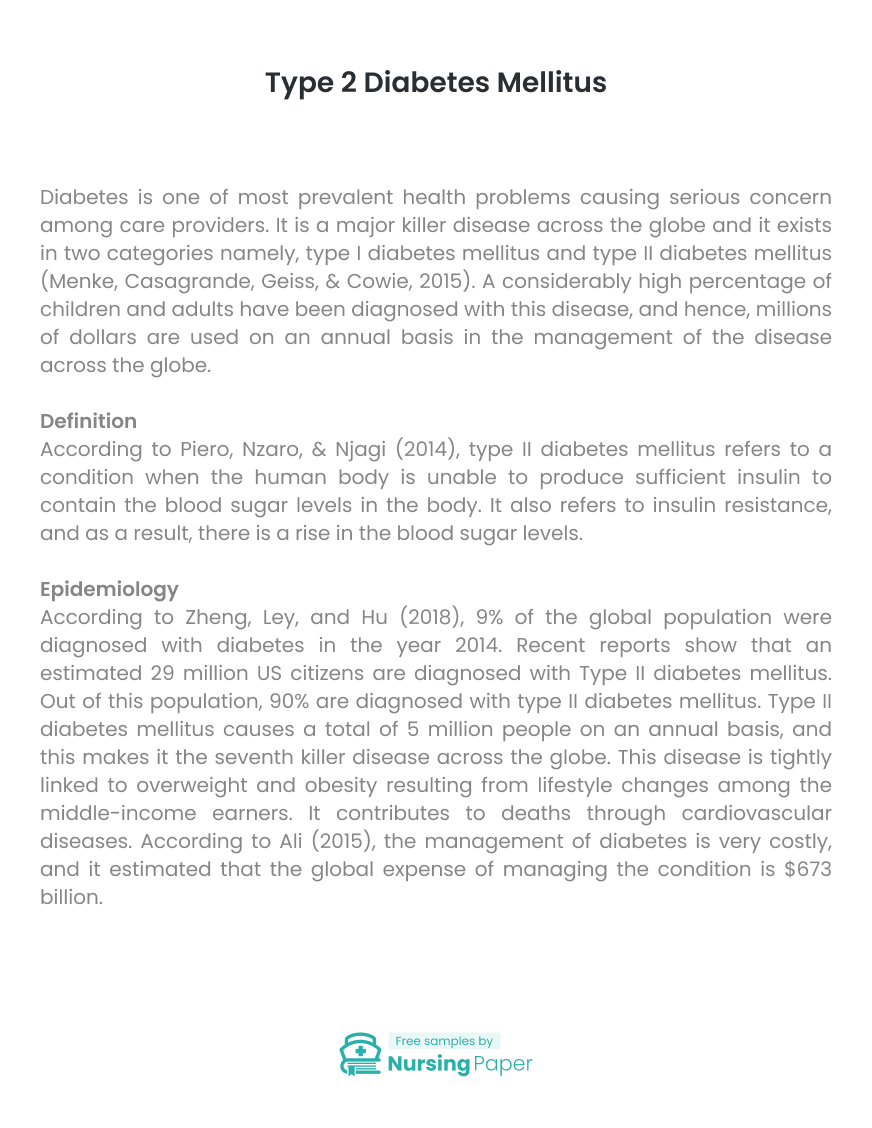
Type 2 Diabetes Mellitus
Introduction
Diabetes is one of most prevalent health problems causing serious concern among care providers. It is a major killer disease across the globe and it exists in two categories namely, type I diabetes mellitus and type II diabetes mellitus (Menke, Casagrande, Geiss, & Cowie, 2015). A considerably high percentage of children and adults have been diagnosed with this disease, and hence, millions of dollars are used on an annual basis in the management of the disease across the globe.
Definition
According to Piero, Nzaro, & Njagi (2014), type II diabetes mellitus refers to a condition when the human body is unable to produce sufficient insulin to contain the blood sugar levels in the body. It also refers to insulin resistance, and as a result, there is a rise in the blood sugar levels.


Epidemiology
According to Zheng, Ley, and Hu (2018), 9% of the global population were diagnosed with diabetes in the year 2014. Recent reports show that an estimated 29 million US citizens are diagnosed with Type II diabetes mellitus. Out of this population, 90% are diagnosed with type II diabetes mellitus. Type II diabetes mellitus causes a total of 5 million people on an annual basis, and this makes it the seventh killer disease across the globe. This disease is tightly linked to overweight and obesity resulting from lifestyle changes among the middle-income earners. It contributes to deaths through cardiovascular diseases. According to Ali (2015), the management of diabetes is very costly, and it estimated that the global expense of managing the condition is $673 billion.
Clinical Presentation of Type II Diabetes Mellitus
- Thirst and increased frequency in urination due to the rise in sugar levels in the patient’s bloodstream (Ali, 2015).).
- A high rate of hunger due to lack of sugar in the body cells, and hence, there is a depletion of energy in the cells and muscle causing hunger.
- Patient weight loss due to hunger and a lack of energy since the body has no glucose to metabolize.
- Recurrent fatigue due to the depletion of sugar and energy in the body.
- Blurry vision
- Formation of dark areas in the skin due to the inability of the body to heal from infections.
Complications
There are several complications associated with diabetes, and a larger percentage of morbidity and mortality are attributed to type II diabetes mellitus. One of the main complications of type II diabetes is diabetic retinopathy, which is a cause of blindness among individuals aged between 20-60 years (Melnyk & Fineout-Overholt, (2015). Another complication associated with type II diabetes mellitus is diabetic nephropathy. This is a renal disease that causes renal failure in advance stages. Another complication is diabetic neuropathy, which makes an individual lose his sense of pain and touch due to damages of nerves. Cardiovascular disease is another complication that is associated with type II diabetes mellitus. According to Menke, Casagrande, Geiss, and Cowie (2015), individuals with type II diabetes mellitus are vulnerable to heart attack and cardiac failure, which are major causes of deaths among elderly individuals diagnosed with diabetes.
Diagnosis
According to Mohan and Unnikrishnan (2014), type II diabetes mellitus is diagnosed through screening and testing of urine and blood of an individual.

Conclusion with PICOT Question
In young adults patients with type II diabetes mellitus, are Complementary and alternative medicine therapies more effective than the conventional Western medicine in the reduction of high blood sugars to healthy levels within a period of 12 months?
1. Ali, M. (2015).A New Approach in Type 2 Diabetes Mellitus Treatment: Evaluation of the beneficial effect of L-cysteine in the treatment of type 2 diabetes mellitus. Hamburg: Anchor Academic Publishing.
2. Melnyk, B. M. & Fineout-Overholt, E. (2015). Evidence-based practice in nursing & healthcare. Philadelphia, PA: Wolters Kluwer.
3. Menke, A., Casagrande, S., Geiss, L., & Cowie, C. C. (2015). Prevalence of and Trends in Diabetes Among Adults in the United States, 1988-2012. JAMA, 314(10), 1021-1029.
4. Mohan, V. & Unnikrishnan, R. (2014). World Clinics: Diabetology – Type 2 Diabetes Mellitus. New Delhi: Jaypee Brothers Medical Publishers.
5. Piero, M. N., Nzaro, G. M., & Njagi, J. M. (2014). Diabetes mellitus – a devastating metabolic disorder. Asian Journal of Biomedical and Pharmaceutical Sciences, 4(40), 1-7.
Zheng, Y., Ley, S. H., & Hu, F. B. (2018). Global aetiology and epidemiology of type 2 diabetes mellitus and its complications. Nat Rev Endocrinol, 14(2), 88-98.



The download will start shortly.

The download will start shortly.
 Subject:
Nursing
Subject:
Nursing  Number of pages: 4
Number of pages: 4  Subject:
Medicine
Subject:
Medicine  Number of pages: 4
Number of pages: 4  Subject:
Nursing
Subject:
Nursing  Number of pages: 3
Number of pages: 3  Subject:
Health and Social Care
Subject:
Health and Social Care  Number of pages: 3
Number of pages: 3  Subject:
Medicine
Subject:
Medicine  Number of pages: 4
Number of pages: 4  Subject:
Medicine
Subject:
Medicine  Number of pages: 3
Number of pages: 3  Subject:
Nursing
Subject:
Nursing  Number of pages: 11
Number of pages: 11  Subject:
Medicine
Subject:
Medicine  Number of pages: 3
Number of pages: 3  Subject:
Nursing
Subject:
Nursing  Number of pages: 5
Number of pages: 5  Subject:
Health and Social Care
Subject:
Health and Social Care  Number of pages: 29
Number of pages: 29  Subject:
Medicine
Subject:
Medicine  Number of pages: 4
Number of pages: 4  Subject:
Health and Social Care
Subject:
Health and Social Care  Number of pages: 3
Number of pages: 3  Subject:
Health and Social Care
Subject:
Health and Social Care  Number of pages: 6
Number of pages: 6  Subject:
Nursing
Subject:
Nursing  Number of pages: 4
Number of pages: 4  Subject:
Medicine
Subject:
Medicine  Number of pages: 3
Number of pages: 3 
